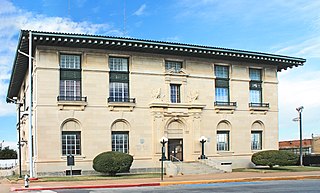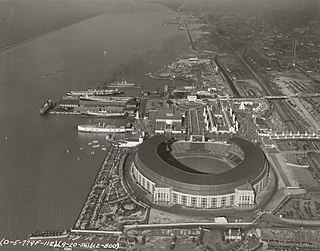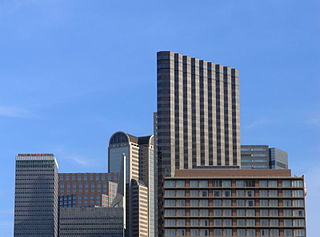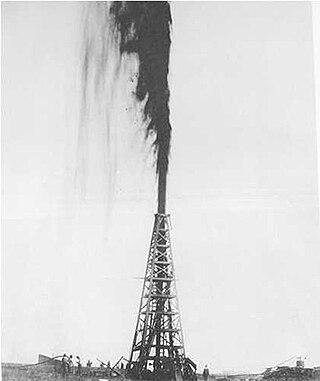
Texas is the most populous state in the South Central region of the United States. It borders Louisiana to the east, Arkansas to the northeast, Oklahoma to the north, New Mexico to the west, and the Mexican states of Chihuahua, Coahuila, Nuevo León, and Tamaulipas to the south and southwest. Texas has a coastline on the Gulf of Mexico to the southeast. Covering 268,596 square miles (695,660 km2), and with over 30 million residents as of 2023, it is the second-largest U.S. state by both area and population.

Sherman is a city in and the county seat of Grayson County, Texas, United States. The city's population in 2020 was 43,645. It is one of the two principal cities in the Sherman–Denison metropolitan statistical area, and is the largest city in the Texoma region of North Texas and southern Oklahoma.

Kilgore is a city in Gregg and Rusk counties in the eastern part of the U.S. state of Texas. Over three-fourths of the area within city limits are located in Gregg County, the remainder in Rusk County. The population was 12,975 at the 2010 census and 13,376 at the 2020 census.
The Great Depression in the United Kingdom also known as the Great Slump, was a period of national economic downturn in the 1930s, which had its origins in the global Great Depression. It was Britain's largest and most profound economic depression of the 20th century. The Great Depression originated in the United States in late 1929 and quickly spread to the world. Britain did not experience the boom that had characterized the U.S., Germany, Canada and Australia in the 1920s, so its effect appeared less severe. Britain's world trade fell by half (1929–33), the output of heavy industry fell by a third, employment profits plunged in nearly all sectors. At the depth in summer 1932, registered unemployed numbered 3.5 million, and many more had only part-time employment. However at the same time, from 1929 to 1933 employment dipped only to 94.9% relative to 1929 employment metrics and recovery was seen as early at 1933. The positive trend continued across real national income and wages. New houses built increased by 33% from 1929 to 1933, while profits, prices, export volume and value, and imports volume and value dropped. Overall, while all these metrics were concerning to parliament and businessmen along with devastating industrial regions, the common person especially in areas around London did not experience major hardship and even prospered.

Fair Park is a recreational and educational complex in Dallas, Texas, United States, located immediately east of downtown. The 277-acre (112 ha) area is registered as a Dallas Landmark and National Historic Landmark; many of the buildings were constructed for the Texas Centennial Exposition in 1936.

The Texas Centennial Exposition was a world's fair presented from June 6 to November 29, 1936, at Fair Park, Dallas, Texas. A celebration of the 100th anniversary of Texas's independence from Mexico in 1836, it also celebrated Texas and Western American culture. More than 50 buildings were constructed for the exposition, and many remain today as notable examples of Art Deco architecture. Attracting more than six million people including US President Franklin Roosevelt, the exposition was credited with buffering Dallas from the Great Depression.

Robert Lee Thornton Sr. was an American banker, civic leader, and four-term Mayor of Dallas, Texas.
Columbus Marion Joiner, nicknamed Dad Joiner, was an American politician oilman who at the age of seventy drilled the discovery well of the East Texas Oil Field of the 1930s. Newspaper articles referred to Joiner as the Daddy of the Rusk County Oil Field.
This article traces the history of Dallas, Texas,.

The Great Lakes Exposition was held in Cleveland, Ohio, in the summers of 1936 and 1937, along the Lake Erie shore north of downtown. The fair commemorated the centennial of Cleveland's incorporation as a city. Conceived as a way to energize a city hit hard by the Great Depression, it highlighted the progress that had been achieved in the Great Lakes region in the last 100 years and indicated the path for future progress. Covering over 135 acres of Cleveland's lakefront, it featured numerous attractions, including rides, sideshows, botanical gardens, cafes, art galleries, and much more. Similar to the Chicago World's Fair, the exposition also wanted to expose visitors to other countries' cultures, celebrate American industry, and promote local businesses. Although the Great Lakes Exposition was not as much of a world fair as the Chicago World's Fair was, the exposition drew 4 million visitors in its first season, and 7 million by the end of its second and final season in September 1937—a total of 13 million visitors.

The East Texas Oil Field is a large oil and gas field in east Texas. Covering 140,000 acres (57,000 ha) and parts of five counties, and having 30,340 historic and active oil wells, it is the second-largest oil field in the United States outside Alaska, and first in total volume of oil recovered since its discovery in 1930. Over 5.42 billion barrels (862,000,000 m3) of oil have been produced from it to-date. It is a component of the Mid-continent oil province, the huge region of petroleum deposits extending from Kansas to New Mexico to the Gulf of Mexico.

The history of Fort Worth, Texas, in the United States is closely intertwined with that of northern Texas and the Texan frontier. From its early history as an outpost and a threat against Native American residents, to its later days as a booming cattle town, to modern times as a corporate center, the city has changed dramatically, although it still preserves much of its heritage in its modern culture.

The history of Dallas, Texas, United States, from 1975 to 1985 concerns the real estate boom.
Alexandre Hogue was an American artist active from the 1930s through the 1980s. He was a realist painter associated with the Dallas Nine; the majority of his works focus on Southwestern United States and South Central United States landscapes during the Dust Bowl.
Harold Dow Bugbee was an American Western artist, illustrator, painter, and curator of the Panhandle-Plains Historical Museum in Canyon, Texas. Bugbee sought with considerable success to become the dominant artist of the Texas South Plains, as his role model, Charles M. Russell of Montana, accordingly sketched life of the northern Great Plains.

Joinerville is an unincorporated community in East Texas. It is located in western Rusk County, Texas, United States.

The Texas oil boom, sometimes called the gusher age, was a period of dramatic change and economic growth in the U.S. state of Texas during the early 20th century that began with the discovery of a large petroleum reserve near Beaumont, Texas. The find was unprecedented in its size (worldwide) and ushered in an age of rapid regional development and industrialization that has few parallels in U.S. history. Texas quickly became one of the leading oil-producing states in the U.S., along with Oklahoma and California; soon the nation overtook the Russian Empire as the top producer of petroleum. By 1940 Texas had come to dominate U.S. production. Some historians even define the beginning of the world's Oil Age as the beginning of this era in Texas.
The Greater Texas & Pan-American Exposition was a World's Fair held at Fair Park in Dallas, Texas (USA). The exhibition promoted the city of Dallas as the cultural and economic capital of an emerging Pan-American civilization stretching from Tierra del Fuego to Alaska. It followed the successful Texas Centennial Exposition, which was held to celebrate the centennial anniversary of Texas in 1936. Every exhibition building constructed for the 1936 fair were simply redecorated for the event, but most major exhibitors did not return in 1937. The event also included the Pan American Olympics, pitting the nations of North, Central, and South America against one another in a series of interracial contests and which led as a precursor for the eventual establishment of the Pan American Games.
The International Petroleum Exposition (IPE) was a specialized trade fair held in Tulsa, Oklahoma, at varying intervals from 1923 to 1979. Its main purposes were to display the latest oil industry technology, sell equipment and services, and to educate industry workers and the general public about the production of oil.

Blockhouse on Signal Mountain is within the Fort Sill Military Reservation, north of Lawton, Oklahoma. The rock architecture is located along Mackenzie Hill Road within the Fort Sill West Range being the Oklahoma administrative division of Comanche County.
















